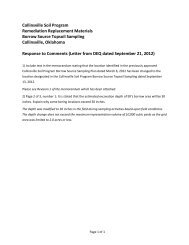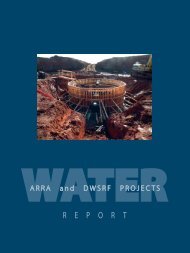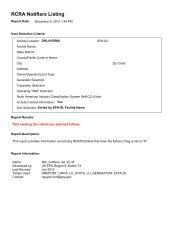Technical documentation and software quality assurance for project ...
Technical documentation and software quality assurance for project ...
Technical documentation and software quality assurance for project ...
You also want an ePaper? Increase the reach of your titles
YUMPU automatically turns print PDFs into web optimized ePapers that Google loves.
€<br />
€<br />
€<br />
€<br />
€<br />
C =1000exp( −100R)<br />
+ 0.8<br />
<strong>and</strong> the Richardson number,<br />
( ) =<br />
ξ D s<br />
⎛<br />
⎜<br />
⎝<br />
g<br />
2 2<br />
Ds u j<br />
⎞<br />
⎟<br />
⎠<br />
1<br />
3<br />
Ds €<br />
ξ( Ds), based on<br />
Chamberlain <strong>for</strong>mula <strong>for</strong> the width at frustum tip, W2 , is<br />
W2 = LB ( 0.18exp( −1.5R)<br />
+ 0.31)<br />
1− 0.47exp −25R<br />
€<br />
The surface area of the flame, A, is calculated as:<br />
A = π<br />
4 W1 2 2 ( + W2 ) + π<br />
2 W1 + W ⎡<br />
2 ⎢<br />
⎣<br />
( ) R L<br />
€<br />
27<br />
D s<br />
( ( ) )<br />
⎛<br />
⎜<br />
⎝<br />
2 + W 2 −W 1<br />
The fraction of the heat, Fs radiated from the flame surface was determined from<br />
experimental data <strong>and</strong> the curve is:<br />
Fs = 0.21exp( −0.00323u j € ) + 0.11<br />
2<br />
2<br />
⎞ ⎤<br />
⎟ ⎥<br />
⎠ ⎦<br />
The view factor F is defined by Sparrow <strong>and</strong> Cess, equation 4-14:<br />
dA cos β i cos β jdA<br />
i<br />
dFA − =<br />
j dAi<br />
A ∫A<br />
2<br />
j π r<br />
j<br />
where:<br />
A is the area of the radiating surface,<br />
j<br />
dA i is the receiving element,<br />
j<br />
β i is the angle between the normal to the receiving element <strong>and</strong> the line between the<br />
element <strong>and</strong> the radiating surface,<br />
β is the angle between the normal to the radiating surface at a point <strong>and</strong> the line<br />
j<br />
between that point <strong>and</strong> the receiving element,<br />
r is the distance between the point on the radiating surface <strong>and</strong> the receiving element.<br />
For a radiating surface of area i<br />
A <strong>and</strong> a receiving element of area j<br />
dA , we can let<br />
q' = incident radiation intensity per unit area, <strong>and</strong><br />
E' = emissive power per unit area,<br />
so<br />
1<br />
2







